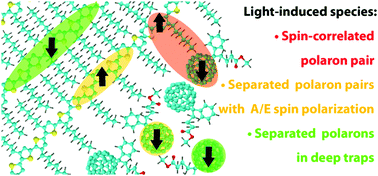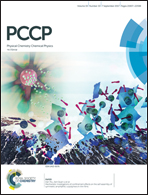Spin dynamics of light-induced charge separation in composites of semiconducting polymers and PC60BM revealed using Q-band pulse EPR†
Abstract
Light-induced processes in composites of semiconducting polymers and fullerene derivatives have been widely studied due to their usage as active layers of organic solar cells. However the process of charge separation under light illumination – the key process of an organic solar cell is not well understood yet. Here we report a Q-band pulse electron paramagnetic resonance study of composites of the fullerene derivative PC60BM ([6,6]-phenyl-C61-butyric acid methyl ester) with different p-type semiconducting polymers regioregular and regiorandom P3HT (poly(3-hexylthiophene-2,5-diyl), MEH-PPV (poly[2-methoxy-5-(2-ethylhexyloxy)-1,4-phenylenevinylene]), PCDTBT (poly[N-9′-heptadecanyl-2,7-carbazole-alt-5,5-(4′,7′-di-2-thienyl-2′,1′,3′-benzothiadiazole)]), PTB7 (poly({4,8-bis[(2-ethylhexyl)oxy]benzo[1,2-b:4,5-b′]dithiophene-2,6-diyl}{3-fluoro-2-[(2-ethylhexyl)carbonyl]thieno[3,4-b]thiophenediyl}))), resulting in a detailed description of the in-phase laser flash-induced electron spin echo (ESE) signal. We found that in organic donor–acceptor composites the laser flash simultaneously induces species of two types: a polymer˙+/fullerene˙− spin-correlated polaron pair (SCPP) with an initial singlet spin state and (nearly) free polymer˙+ and fullerene˙− species with non-equilibrium spin polarization. Species of the first type (SCPP) are well-known for polymer/fullerene blends and are usually associated with a charge-separated state. Also, spin polarization of long-living free species (polarons in deep traps) is affected by the laser flash, which is the third contribution to the flash-induced ESE signal. A protocol for extracting the in-phase ESE signal of the SCPP based on the dependence of the microwave nutation frequency on the strength of the spin coupling within the polaron pair was developed. Nutation experiments revealed an unusual pattern of the SCPP in RR-P3HT/PC60BM composites, from which the strength of the exchange interaction between the polymer˙+ and fullerene˙− was extracted. In composites with low-efficient polymers the contribution of the SCPP to the in-phase ESE signal is high, while in composites with high-efficient polymers it is low. This finding can be used as a selection criterion of charge separation efficiency in the polymer/fullerene composites.



 Please wait while we load your content...
Please wait while we load your content...